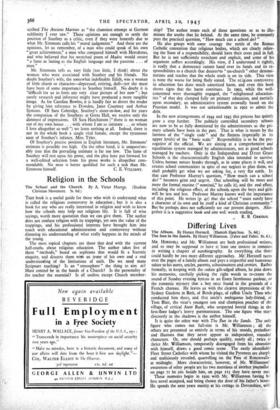Religion in the Schools
The School and the Church. By A. Victor Murray. (Student Christian Movement. 3s. 6d.)
THIS book is a useful guide for those who wish to understand what is called the religious controversy in education ; but it is also a book for any who are really interested in religion and wish to know how the schools may help our religious life. It is full of wise sayings, worth more quotation than we can give them. The author does not confuse religion with its trappings, yet sees the value of the trappings, and his professional interests have brought him into touch with educational administration and controversy without dimming his understanding of what really happens in the minds of the young.
The most topical chapters are those that deal with the current half-truths about religious education. The author takes five of these " methods," based on sophisms that would fit a Socratic enquiry, and dissects them with an irony of his own and a real understanding of the limitations of each. Do we need more Scripture teaching? Is an " atmosphere " the thing to aim at? Must control be in the hands of a Church? Is the personality of the teacher the essential? Is all useless except Church member- ship? The author treats each of these questions so as to illu- minate the truths that lie behind. At the same time, he constantly puts the practical question, "How much can a school do? "
He also grasps with some courage the nettle of the Roman Catholic contention that religious bodies, which are clearly reliev- ing the State of a responsibility, should have their costs paid in full. But he is not sufficiently trenchant and explicit, and some of his argument suffers accordingly. His view, if I understand it rightly, is really that a democracy cannot hand over its funds and its re- sponsibilities to a church that desires•to " un-church " other denomi- nations and teaches that the whole truth is on its side. This view is none the worse for being flatly stated. The re:igious controversy in education has done much unnoticed harm, and even this book shows signs that the harm continues. In 1902, while the well- concerned were thoroughly engaged, the " enlightened education- ists " of that day clamped fully on primary education, and partially upon secondary, an administrative system avowedly based on the Prussian model. It was not unfashionable in 1902 to admit the debt.
In the new arrangements of 1944 and 1945 this process has quietly gone a step further. The publicly controlled secondary schools arc now to be as fully dominated by the administrators as the pri- mary schools have been in the past. That is what is meant by the fairness of the " single code " and the flatness (especially in its upper levels) of the " basic scale." Responsibility is to be the pre- rogative' of the official. We are aiming at a comprehensive and equalitarian system managed by administrators, not at good schools
managed by teachers. Only in the Independent and D:rect Grant Schools is the characteristically English idea intended to survive. Unless human nature breaks through, as in some places it will, and creates school communities in spite of our neglect to plan them, we shall probably get what we are asking for, a very flat earth. In that case Professor Murray's question, " How much can a school do? " becomes grim and urgent. Our schooling will be more and more the formal routine (" nominal," he calls it), and the real effect, inc:uding the religious effect, of the schools upon the boys and girls
will be less and less. Professor Murray knows well the importance of this point. He writes (p. 42) that the school " must surely have a character of its own and be itself a kind of Christian community." But =he perhaps does not sufficiently see our present dangers. Alto- gether it is a suggestive book and one well worth reading.
R. B. GRAHAM.


























 Previous page
Previous page